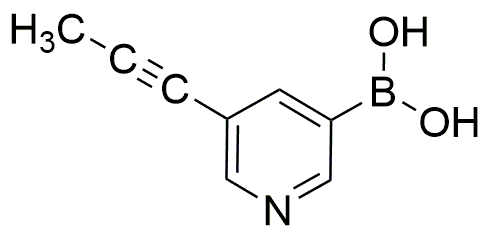5-(1-Propynyl)pyridine-3-boronic acid is widely utilized in research focused on:
- Pharmaceutical Development: This compound serves as a key intermediate in the synthesis of various pharmaceuticals, particularly in the development of anti-cancer agents due to its ability to form stable complexes with biomolecules.
- Organic Synthesis: It is employed in cross-coupling reactions, such as Suzuki-Miyaura reactions, to create complex organic molecules, making it invaluable in the production of agrochemicals and fine chemicals.
- Material Science: The compound is used in the creation of functional materials, including sensors and catalysts, thanks to its unique electronic properties and ability to form strong bonds with other materials.
- Bioconjugation: It is utilized in bioconjugation techniques to attach biomolecules to surfaces or other molecules, facilitating advancements in drug delivery systems and diagnostic tools.
- Research in Catalysis: This boronic acid derivative plays a significant role in catalytic processes, enhancing reaction efficiency and selectivity, which is crucial for sustainable chemistry practices.
General Information
Properties
Safety and Regulations
Applications
5-(1-Propynyl)pyridine-3-boronic acid is widely utilized in research focused on:
- Pharmaceutical Development: This compound serves as a key intermediate in the synthesis of various pharmaceuticals, particularly in the development of anti-cancer agents due to its ability to form stable complexes with biomolecules.
- Organic Synthesis: It is employed in cross-coupling reactions, such as Suzuki-Miyaura reactions, to create complex organic molecules, making it invaluable in the production of agrochemicals and fine chemicals.
- Material Science: The compound is used in the creation of functional materials, including sensors and catalysts, thanks to its unique electronic properties and ability to form strong bonds with other materials.
- Bioconjugation: It is utilized in bioconjugation techniques to attach biomolecules to surfaces or other molecules, facilitating advancements in drug delivery systems and diagnostic tools.
- Research in Catalysis: This boronic acid derivative plays a significant role in catalytic processes, enhancing reaction efficiency and selectivity, which is crucial for sustainable chemistry practices.
Documents
Safety Data Sheets (SDS)
The SDS provides comprehensive safety information on handling, storage, and disposal of the product.
Product Specification (PS)
The PS provides a comprehensive breakdown of the product’s properties, including chemical composition, physical state, purity, and storage requirements. It also details acceptable quality ranges and the product's intended applications.
Certificates of Analysis (COA)
Search for Certificates of Analysis (COA) by entering the products Lot Number. Lot and Batch Numbers can be found on a product’s label following the words ‘Lot’ or ‘Batch’.
Numéro de catalogue
Numéro de lot/série
Certificates Of Origin (COO)
This COO confirms the country where the product was manufactured, and also details the materials and components used in it and whether it is derived from natural, synthetic, or other specific sources. This certificate may be required for customs, trade, and regulatory compliance.
Numéro de catalogue
Numéro de lot/série
Safety Data Sheets (SDS)
The SDS provides comprehensive safety information on handling, storage, and disposal of the product.
DownloadProduct Specification (PS)
The PS provides a comprehensive breakdown of the product’s properties, including chemical composition, physical state, purity, and storage requirements. It also details acceptable quality ranges and the product's intended applications.
DownloadCertificates of Analysis (COA)
Search for Certificates of Analysis (COA) by entering the products Lot Number. Lot and Batch Numbers can be found on a product’s label following the words ‘Lot’ or ‘Batch’.
Numéro de catalogue
Numéro de lot/série
Certificates Of Origin (COO)
This COO confirms the country where the product was manufactured, and also details the materials and components used in it and whether it is derived from natural, synthetic, or other specific sources. This certificate may be required for customs, trade, and regulatory compliance.


